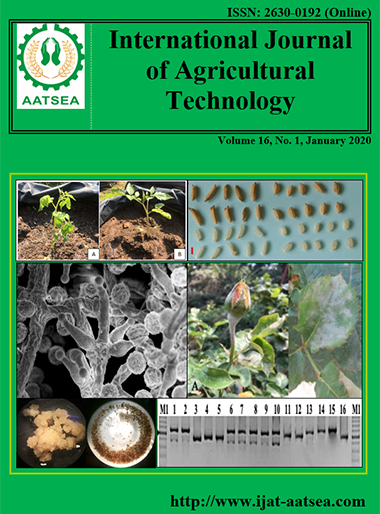Effects of pre-process elicitor immersion on the physicochemical qualities of fresh-cut papaya fruits cv. ‘Holland’ during cold storage
Main Article Content
Abstract
Postharvest treatment of elicitors such as salicylic acid (SA) and methyl jasmonate (MeJA) improved postharvest quality of fruit and vegetables. The effect of pre-process immersions on SA or MeJA on the physicochemical quality changes of fresh-cut papaya fruits cv. ‘Holland’ during cold storage is hereby reported. The fruits were immersed in 2 mM SA or 10-4 M MeJA for 1 hour and then stored at room temperature (26 ± 1 °C) for 24 hours before fresh-cut processing. The biochemical parameters such as firmness, total soluble solids (TSS), colour attributes, antioxidant activities and bioactive compounds of fresh-cut papaya fruit during storage at 4 °C for 8 days were monitored. Both SA and MeJA treatments effectively maintained firmness but had no influence on the changes in TSS and colour attributes on storage. Antioxidant capacity of the fresh-cut papaya was enhanced by SA or MeJA immersion. While, free radical scavenging activity was induced by SA immersion. The amounts of total phenols and flavonoids of SA treated fresh-cut papaya fruit were higher than in the control. MeJA immersion induced flavonoids content but not total phenols. The pre-process immersion of SA and MeJA could maintain texture and improve nutritional quality of fresh-cut papaya fruit during storage.
Article Details

This work is licensed under a Creative Commons Attribution-NonCommercial-NoDerivatives 4.0 International License.
References
Aghdam, M. S. and Bodbodak, S. (2013). Physiological and biochemical mechanism regulating chilling tolerance in fruit and vegetables under postharvest salicylates and jasmonates treatments. Scientia Horticulturae, 156:73-85.
Asghari, M. and Aghdam, M. S. (2010). Impact of salicylic acid on post-harvest physiology of horticultural crops. Trends Food Science and Technology, 21:502-509.
Benzie, I. F. F. and Strain, J. J. (1996). The ferric reducing ability of plasma (FRAP) as a measure of “antioxidant power”: The FRAP assay. Analytical Biochemistry, 239:70-76.
Boonyaritthongchai, P. and Supapvanich, S. (2017). Effects of methyl jasmonate on physicochemical qualities and internal browning of ‘queen’ pineapple fruit during cold storage. Horticulture Environment and Biotechnology, 58:479-487.
Brand-Williams, W., Cuvelier, M. E. and Berset, C. (1995). Use of free radical method to evaluate antioxidant activity. LWT – Food Science and Technology, 28:25-30.
González-Aguilar, G. A., Buta, J. G. and Wang, C. Y. (2003). Methyl jasmonate and modified atmosphere packaging (MAP) reduce decay and maintain postharvest quality of papaya ‘Sunrise’. Postharvest Biology and Technology, 28:361-370.
González-Aguilar, G. A., Tiznado-Hernández, M. E., Zavaleta-Gatica, R. and Martı́nez-Téllez, M. A. (2004). Methyl jasmonate treatments reduce chilling injury and activate the defense response of guava fruits. Biochemical and Biophysical Research Communications, 313:694-701.
Jia, Z., Tang, M. and Wu, J. (1999). The determination of flavonoid contents in mulberry and their scavenging effects on superoxide radical. Food Chemistry, 64:555-559.
Karakurt, Y. and Huber, D. J. (2003). Activities of several membrane and cell-wall hydrolases, ethylene biosynthetic enzymes, and cell wall polyuronide degradation during low-temperature storage of intact and fresh-cut papaya (Carica papaya) fruit. Postharvest Biology and Technology, 28:219-229.
Karakurt, Y. and Huber, D. J. (2007). Characterization of wound-regulated cDNAs and their expression in fresh-cut and intact papaya fruit during low-temperature storage. Postharvest Biology and Technology, 44:179-183.
Promyou, S. and Supapvanich, S. (2016). Effects of salicylic acid immersion on physicochemical quality of Thai papaya fruit ‘Kaek Dam’ during storage. Acta Horticulturae, 1111:105-112.
Reyes-Díaz, M., Lobos, T., Cardemil, L., Nunes-Nesi, A., Retamales, J., Jaakola, L., Alberdi, M. and Ribera-Fonseca, A. (2016). Methyl jasmonate: an alternative for improving the quality and health properties of fresh fruits. Molecules, 21:567. doi: 10.3390/molecules21020567.
Rivera-Domínguez, M., Astorga-Cienfuegos, K. R., Tiznado-Hernández, M. E. and González-Aguilar, G. A. (2012). Induction of expression of defence genes in Carica papaya fruit by methyl jasmonate and low temperature treatment. Electronic Journal of Biotechnology, 15: doi.10.2225/vol15-issue5-fulltext-7.
Sangprayoon, P., Supapvanich, S., Youryon, P., Wongs-Aree, C. and Boonyaritthongchai, P. (2019). Efficiency of salicylic acid or methyl jasmonate immersions on internal browning alleviation and physicochemical quality of Queen pineapple cv. “Sawi” fruit during cold storage. Journal of Food Biochemistry, doi.10.1111/jfbc.13059.
Slinkard, K. and Singleton, V. L. (1997). Total phenol analysis: Automation and comparison with manual methods. American Journal of Enology Viticulture, 28:49-55.
Supapvanich, S. and Promyou, S. (2013). Effeciency of salicylic acid application on postharvest perishable crops. In: Hayat S and Alyemei AAM eds. Salicylic acid: Plant growth and development, New York, Springer. pp. 339-355.
Supapvanich, S. and Promyou, S. (2017). Hot water incorporated with salicylic acid dips maintaining physicochemical quality of ‘Holland’ papaya fruit stored at room temperature. Emirates Journal of Food and Agriculture, 29:18-24.
Supapvanich, S. and Tucker, A. G. (2013). Cell wall hydrolysis in netted melon fruit (Cucumis melo var. reticulatus L. Naud) during storage. Chiang Mai Journal of Science, 40:447-458.
Supapvanich, S., Mahasap, B., Boonyaritthongchai, P., Techavuthiporn, C., Tepsorn, R. and Youryon, P. (2017). Salicylic acid immersion maintains physiochemical quality and enhances bioactive compounds in ‘Kimju’ guava fruit during cold storage. Emirates Journal of Food and Agriculture, 29:620-628.
Supapvanich, S., Kernprie, Y., Boonyaritthongchai, P., Techavuthiporn, C., Tepsorn, R. and Youryon, P. (2019). Physicochemical quality maintenance and bioactive compounds enhancement of Thai guava fruit cv. ‘Kimju’ by using combinative hot water and methyl jasmonate immersion. Emirates Journal of Food and Agriculture, 31:395-404.
Watada, A. E. and Qi, L. (1999). Quality of fresh-cut produce. Postharvest Biology and Technology, 15:201-205.


